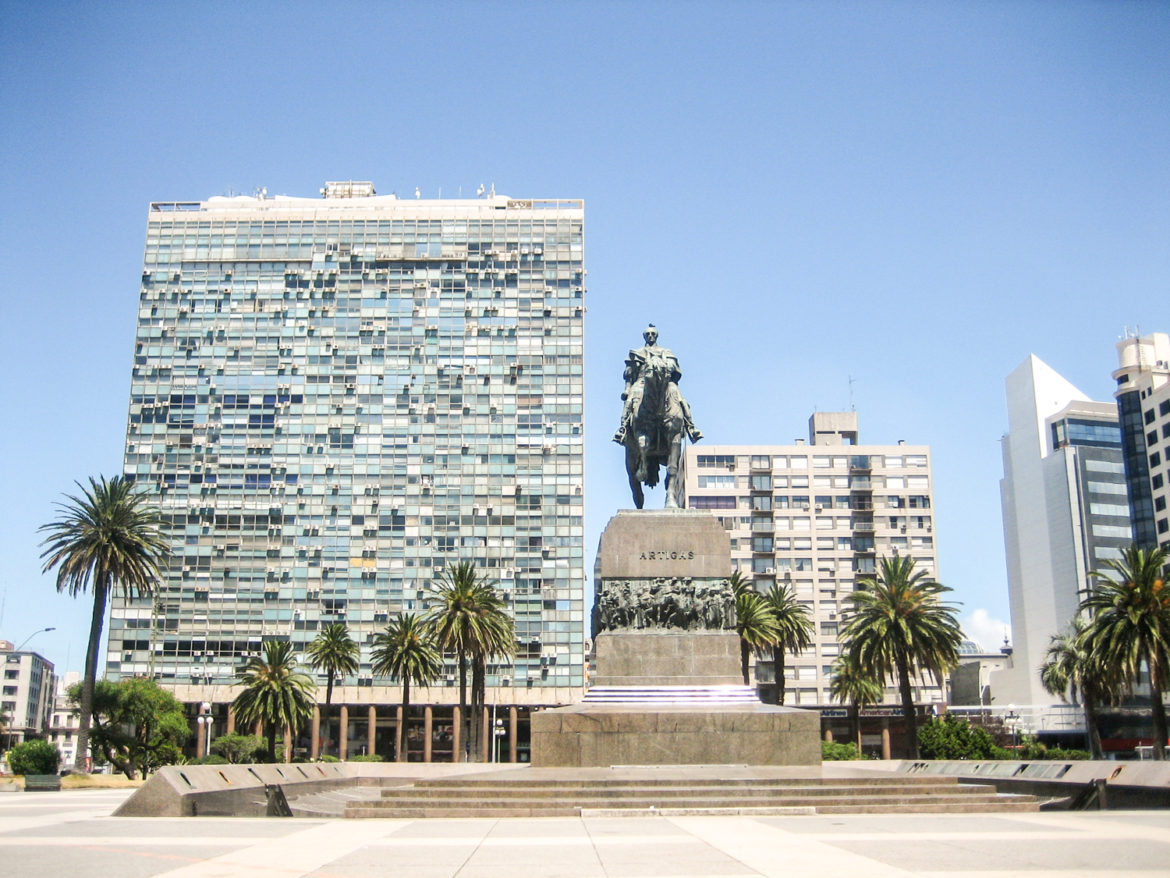Montevideo, the laidback capital of Uruguay, delights with a well-preserved old town, relaxed beach scene and unique personality all its own.
Uruguay is an often overlooked travel destination compared to neighboring countries, Argentina and Brazil. But for travelers who are savvy enough to include it in their itinerary, they’ll discover it’s a fascinating place. And with less tourists, it’s also a more enjoyable and budget-friendly place to visit.
Montevideo is a relatively small city (and the southernmost capital in the Americas) with a population of about 1.8 million. In the early 1800s, it was occupied by British, Spanish, Argentine, Portuguese and Brazilian forces. This complicated history is precisely what makes it such a culturally vibrant city. From the art of mate drinking to Candombe, the Afro-Uruguayan style of music and dance, Montevideo has much to offer.
The Ciudad Vieja (“Old Town”) was our introduction to the charms of Montevideo.
In Plaza Independencia, the main square, a statue of Uruguay’s national hero stands against modern and neo-Gothic architecture. José Gervasio Artigas was a democrat and federalist whose ideals were inspired by American political liberalism. Below his statue lies an underground mausoleum in his honor protected by a traditional guard. It’s an interesting place to meander. Along the walls, bold typography proclaims the accomplishments of Artigas’ life.
Back on ground level, it’s hard to miss Palacio Salvo. Designed by an Italian architect, it’s the tallest building in Plaza Independencia and the city’s most iconic landmark. In the early 1900s, it was first built as a luxury hotel and featured a lighthouse on top (!) It’s particularly striking among the palm trees and flowering bushes.
From Plaza Independencia, we took a leisurely stroll through Old Town.
Montevideo has a thriving cafe culture among its art galleries and antique shops. We checked out the neoclassical Solís Theatre, then headed to the Museo Torres Garcia. This intriguing museum features the work of 20th-century Uruguayan painter, Joaquín Torres-García. As the founder of Universal Constructivism, he created a revolutionary style of art. He applied universal pictographs such as the sun, moon, time and people, to the geometric structure and principles of Constructivism. Torres-García was considered one of the most important artists in the early 20th century.
Afterwards, we got to experience our first traditional Asado at L’Amitie at Mercado de Puerto. Asado is both a technique and social gathering, inspired by the cooking style of South America’s gauchos. Better known as a barbecue, it entails meats and vegetables cooked over a parrilla (“grill”). Perusing the market, we watched intently as an asador (“grill master”) tended the fire of his enormous grill. Joining the throngs of locals and tourists outside, we found an open table and hunkered down for the three-hour lunch. Completing our meal was Medio y Medio. This is Uruguay’s signature cocktail: equal parts dry white wine and sweet sparkling wine. Delicious.
We walked off lunch at the nearby Museo del Carnaval. This museum features a variety of masks, drums and costumes from over a century of Uruguay’s carnival celebrations. Dating back to ancient Europe, Carnival reflects the different beliefs and traditions of the country’s multi-ethnic culture. Known as the World’s Longest Party, festivities take place for 40 days beginning in February.
On the opposite side of town lies Montevideo’s popular beaches.
Playa Pocitos is a particularly nice, wide beach situated in an upscale residential neighborhood along the Rio Plata. We first saw this chocolatey brown river en route to Colonia del Sacramento from Buenos Aires by ferry. We spent a couple of hours strolling the Rambla, the city’s waterfront boardwalk. At 13 miles, it’s is also the longest continuous sidewalk in the world. Running along the entire coast of Montevideo, the Rambla is great people-watching. Locals sunbathe, ride bikes and sip mate – and it’s like this almost every day.
Other interesting places for a walk include the Japanese Garden and the extensive Botanical museum and gardens, featuring plants from all over the world.
While walking through downtown, we stumbled on la Fuente de los Candados (“The Love Locks Fountain”). This is one of the city’s major attractions. Legend says that when a couple places a lock on the fountain, their love is forever sealed. While the origin is unknown, the phenomenon of love locks has gained momentum worldwide. They can be found in various cities all over the world including Paris, France and Seoul, South Korea.
Thirty miles north of Montevideo lies Canelones, Uruguay’s largest and most important wine region.
We took a day trip here through a locally organized tour. After visiting the beautiful El Prado neighborhood, we headed out to the countryside. At family-owned winery, Bodega Bouza, we enjoyed an amazing five-course tasting menu with wine pairings. Afterwards, we wandered their vineyards to see where the famous Tannat grape is grown. The winery also has a classic car collection, Bouza Vinos Garage, where guests can also enjoy tapas-style dining.
To complete our Montevideo visit, we treated ourselves to an evening at El Milongon. This vibrant dinner show features the best of Uruguayan folk culture, music and tradition. In addition to tango, we witnessed a spectacular performance of the renowned Candombe. This tradition, originated by slaves during colonial times, is now on the UNESCO’s Representative List of the Intangible Cultural Heritage of Humanity.
With a glass of Tannat in hand, we enjoyed the glimpse into Uruguay’s rich heritage and unique cultural identity, marveling at this true expression of celebrating life.

